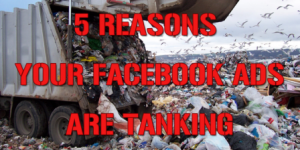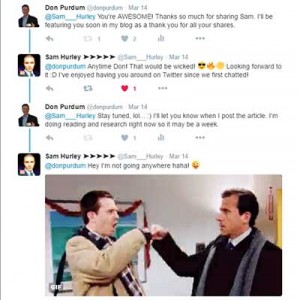With more and more PPC tasks becoming automated, it’s important to understand the limitations of automation. Here are eight of the most common issues to avoid when moving from manual to automated bidding.

Last week, I wrote that no one should do manual pay-per-click (PPC) bidding in this day and age. But that doesn’t mean you can just flip an automated bidding switch on and head for the beach. In fact, automated bidding comes with its own unique challenges that still require the active involvement of an account manager. So, let’s take a look at some of the most common issues to avoid when moving from manual to automated bidding.
Machines learn from your manual work
Probably the biggest “gotcha” about bid automation from Google is that it relies on machine learning, and, as that name implies, the machine has to learn before it can take over management. While it can learn some things from the history of all advertisers, it also needs historical data about the account it will start to automate. And that means that you’ll have to run campaigns manually first to get them to a point where conversions are plentiful and performance is consistent.
So, was I wrong to say that there is no place for manual bid management when it seems to be a required step on the path to fully automated bidding? The key word there is fully automated. There are varying levels of PPC automation, and even when a level 3 or 4 automation is impossible, there are still lower levels of automation to consider.
Use the right level of automation for your circumstances
While the focus of automation usually revolves around Google’s Smart Bidding and Smart Campaigns, keep in mind that there are many other forms that automation can take. For example, if you’re just starting a new campaign and need to build up enough data before Smart Bidding can work, you may still want to automate things like building out the campaign from structured data you have on a spreadsheet.
And during the initial management of that campaign, you can use automated rules, a rule engine, AdWords Scripts, spreadsheet macros and the like to speed up finding queries that should be added as keywords and keywords whose bids should be changed based on performance.
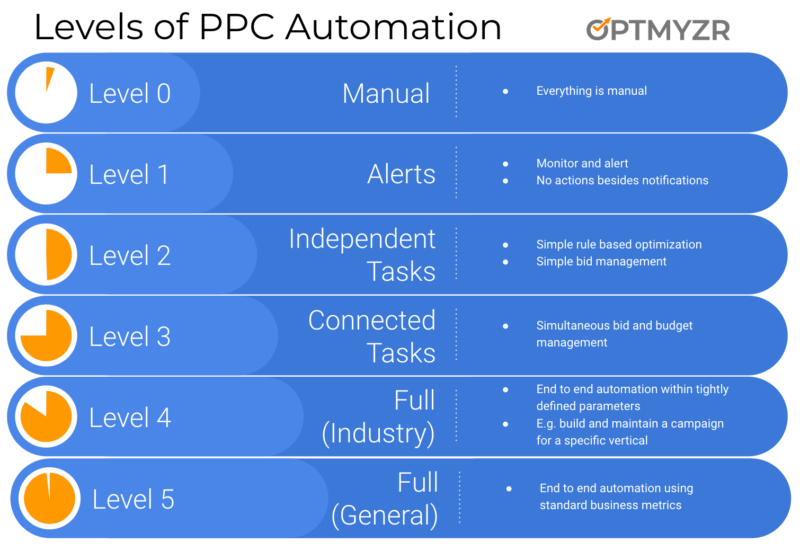
When I say that bids should never be managed manually, I mean your time is likely too valuable to manually pull reports from Google Ads (formerly AdWords). You can go through them manually to apply filters and find things to change before finally bulk uploading it manually via the ads editor. When several steps of a process are so well defined, you can save time by automating them, and you probably should.
You don’t have enough data
After running campaigns for a while, some advertisers will have enough data to turn on machine learning-driven bid automation. But many smaller accounts may continue to struggle to meet the minimum thresholds for the data the system needs. Google says that smart bidding can work with 15 conversions in the past 30 days but says 50 conversions would be better. And for advertisers with modest budgets, say $1,000 per month, it may be nearly impossible to meet those levels.
They could use a non-smart bid strategy, but these are disconnected from smart business goals, so use caution if you go down that route. I call it “vanity bidding” rather than “smart bidding.”
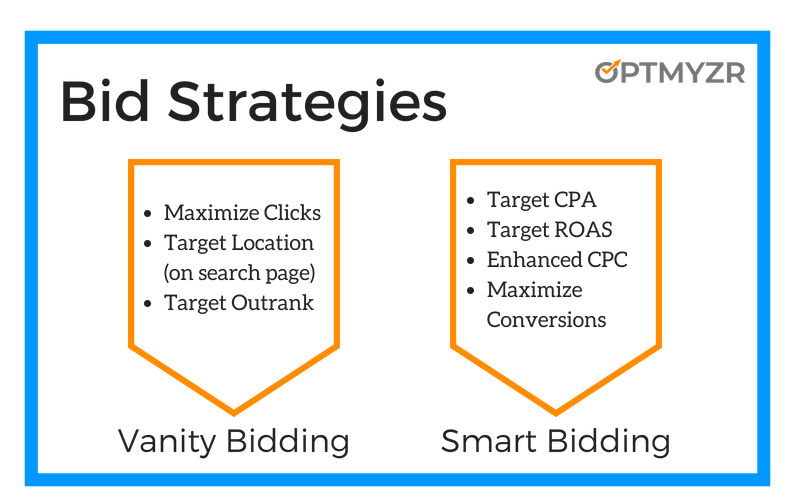
Perhaps a better workaround when you have a small account with insufficient data is to use micro conversions rather than macro conversions. Because micro conversions are easier to get, you may be able to get enough of them every month to make smart bidding work. And if you’ve defined micro conversions as an action that is closely correlated with eventual macro conversions, the automated bids will still help to move your account in the right direction.
Whether you’re simply waiting to get enough data for a new campaign or are persistently stuck on the wrong side of the minimum data threshold, consider using rule-based bid automation. Unlike portfolio bidding systems, rule-based bid automation can work with far less data and can mimic the manual process you might already be doing today.
For example, use a tool that finds keywords with higher-than-expected spend and no conversions, and flag those keywords for a review, or even automatically lower the bid. I maintain there is no scenario in which you should do bidding entirely manually, not even while you’re building initial history.
Automation can’t magically fix your business
When you start automating bids, a key setting is usually the target cost per acquisition (CPA) or return on advertising spend (ROAS).
Personally, I love a $0.01 CPA for my personal injury lawyer leads, and that 10,000 percent ROAS for my web store sounds pretty good, too. Let’s do it, Google!
The reality is that automation works best when you start off with targets that are similar to recent performance. From there, automation can drive incremental improvements, but they won’t typically deliver mind-blowing improvements. Mind-blowing improvements still require changes to the offer, the landing page, the price, the service level and all the other factors that make some businesses more successful than others.
I love to layer some automation on top of Smart Bids from Google. It can start with the historical CPA we’ve achieved, but through a rule engine tool, we detect when Google is meeting the goal and then make the target just harder to reach by reducing the CPA or increasing the ROAS. We do this automatically over time so that we’re finding the optimal targets to use.
Inferior tools cause unexpected harm
One fundamental problem with some automation is that it lives in a vacuum and may miss the bigger picture which can lead to bad results. Take the “maximize clicks” bid strategy for example. Because it is not a Smart Bidding strategy it has no context for the quality of conversions, meaning that it does not know if a click is a good click or a bad click. But because this strategy operates on the same auctions where many of your competitors are using conversion tracking to distinguish between good and bad clicks, things will go badly for the advertiser using the inferior strategy.
With a click-maximization goal, can you guess which clicks are going to be the cheapest, and hence the best ones to buy, if the goal is simply to get the most possible clicks for a budget? The ones ignored by other advertisers who are using conversion tracking! Smart advertisers avoid these clicks because they know they probably won’t convert.
So, while you can get a lot of these cheap clicks, they’re cheap for a reason, and you might actually have been able to drive more results by buying fewer but more expensive clicks, a strategy used by savvy advertisers.
Things move fast and can spiral out of control
Remember the 2010 Flash Crash of the US stock markets? It was caused by high-frequency automated trading algorithms that got caught in a bad feedback loop. This is exactly what can happen when one key component of automated bidding fails.
Say your conversion tracking is broken briefly. Bid automation quickly identifies the decline in conversion rate and bids are reduced.
When the bids go too low, the ads are relegated to the second page of results, where they get far less visibility. Once the conversion tracking is fixed, it may be too late, and the automated system may fail to get enough new data to establish that things are fine again and that bids should be raised. Hence bids remain low, and lots of opportunities are lost until a human identifies the mistake.
One way to counteract this is to periodically audit all keywords that used to be on page one but are now below the first-page bid estimate. They may well have low bids for good reason (because they convert poorly), but it’s worth periodically retesting these keywords in higher positions to see if improvements to landing pages and special offers could get them to be successful at first-page bid levels.
Set it and forget it
Automated bidding is called automated because it bridges the gap between the cost-per-click (CPC) bids Google uses to rank ads in each auction and the CPA and ROAS goals most advertisers have. That’s the extent of the automation. Figuring out the correct target is still a task for the account manager.
But beyond determining the initial setting, PPC pros should adjust their targets periodically. One reason to adjust the target is to account for short-term factors that will change conversion rates and typical sales volumes. Google even says this in their documentation. The machine learning that predicts conversions may not be able to pick up instantly on the fact that your conversion rate will double because you’re running the best sale you’ve ever had. So rather than wait for it to catch up and lose potential sales, take charge of the situation and update the target CPA.
Tying your hands with account structure
The perfect account structure is a topic of constant debate. I think the perfect structure is a fluid one. The reason account structure is important is that for most people, it’s their window into how the ads system is performing. By grouping different brands into their own campaigns, you can instantly get an indication of the ROAS of each brand by looking at a campaign report.
But what if you want to know performance by the size of the t-shirts you sell? Unless your structure includes the size, that’s a near-impossible question to answer.
I advocate using detailed, granular structures like a group of individual products (GRIP) structure for shopping ads because technology can be used to compile reports based on any factor on the fly, and with a granular structure, you can then act on new findings with better bids or other common PPC optimizations.
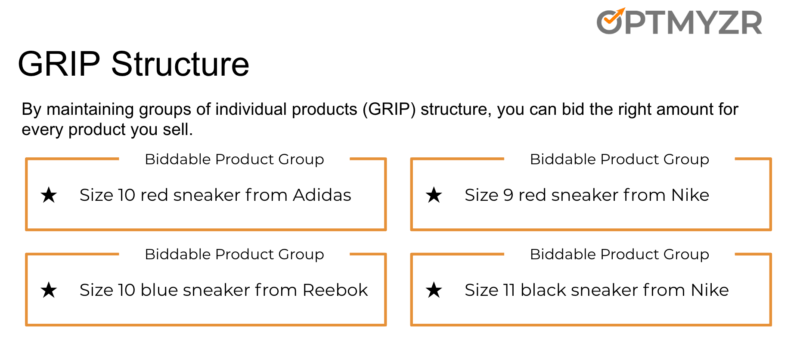
When it comes to Smart Shopping Campaigns, Google recommends grouping items with similar ROAS together. But with a shopping feed, that could mean you need to have a campaign that includes a mix of stock-keeping units (SKUs) of all different product types, and that’s complex to build.
Even more so, it’s complex when performance evolves and items need to be moved between campaigns to remain in the right bucket. A fluid structure takes care of this, and it’s something you can automate with commercial tools or Google Ads 360.
Conclusion
As we enter into a world where more and more PPC tasks are automated, it’s important to understand the limitations of automation and to figure out how PPC pros can remain relevant to help drive amazing business results. When it comes to automating your bids, I hope you’ll avoid the eight pitfalls I’ve covered here.
[Article on Search Engine Land.]
Opinions expressed in this article are those of the guest author and not necessarily Marketing Land. Staff authors are listed here.
Marketing Land – Internet Marketing News, Strategies & Tips
(79)
Report Post


